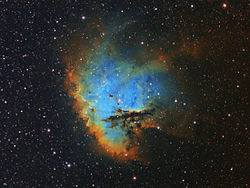NGC 281
| NGC 281 | |
 Emissionsnebulosan NGC 281. | |
| Observationsdata | |
|---|---|
| Typ | Emissionsnebulosa |
| Stjärnbild | Cassiopeja |
| Rektascension | 00t 52m 59,3s[1] |
| Deklination | +56° 37′ 19″[1] |
| Avstånd | 9 500[2] (2 900 ± pc) ljusår |
| Skenbar storlek | 35 bågsekunder |
| Fysiska egenskaper | |
| Radie | 48 ljusår |
| Upptäckt | |
| Upptäcktsår | 16 november 1881 |
| Upptäckare | Edward Barnard |
| Andra beteckningar | |
| IC 11, Sh2-184,[3] Sharpless 184,[1] LBN 616, LBN 123.17-06.28, Pacman Nebula | |
| Se även: Nebulosor, Lista över nebulosor | |
NGC 281, IC 11 eller Sh2-184 är en ljusstark emissionsnebulosa och en del av en H II-region i stjärnbilden Cassiopeja där den ingår i Vintergatans Perseus spiralarm. Den är också känd som Pacmannebulosan för sin likhet med tv-spelskaraktären. Den upptäcktes av Edward Barnard den 16 november 1881. Objektet är förbundet med den öppna stjärnhopen IC 1590, multipelstjärnan HD 5005 och flera bokglobuler.
Nebulosan är synlig i amatörteleskop från en mörk himmel. I sin bok Deep Sky Wonders beskriver Walter Scott Houston nebulosans utseende i små teleskop:[4]
"Den var en svag glöd i närheten av multipelstjärnan, med ett tillfälligt intryck av en mycket större nebulositet ... Dess ytljus var mycket mindre än M33 i Triangeln eller NGC 205, Andromedagalaxens avlägsna följeslagare."


Referenser
- Den här artikeln är helt eller delvis baserad på material från engelskspråkiga Wikipedia, NGC 281, 23 juni 2021.
Noter
- ^ [a b c] ”NASA/IPAC Extragalactic Database”. Results for NGC 281. http://nedwww.ipac.caltech.edu/. Läst 17 oktober 2006.
- ^ Leass, E. A.; Biller, B.; Dame, T. M.; Megeath, S. T. (2001). ”An Expanding Complex of Molecular Clouds High Above the Perseus Spiral Arm”. American Astronomical Society, 199th AAS Meeting, #91.16; Bulletin of the American Astronomical Society 33: sid. 1439. Bibcode: 2001AAS...199.9116L.
- ^ http://simbad.u-strasbg.fr/simbad/sim-id?Ident=NGC+281. Hämtad 2021-06-23.
- ^ Houston, Walter Scott (2005). Deep-Sky Wonders. Sky Publishing Corporation. ISBN 978-1-931559-23-2
Externa länkar
 Wikimedia Commons har media som rör NGC 281.
Wikimedia Commons har media som rör NGC 281.- NGC 281 Astronomy picture of the Day (August 23, 2005) at NASA
- NGC 281 at ESA/Hubble
- NGC 281 at Deep Space Map
| ||||||||
Media som används på denna webbplats
NGC 281 is a bustling hub of star formation about 10,000 light years away. This composite image of optical and X-ray emission includes regions where new stars are forming and older regions containing stars about 3 million years old.
The optical data (seen in red, orange, and yellow) show a small open cluster of stars, large lanes of obscuring gas and dust, and dense knots where stars may still be forming. The X-ray data (purple), based on a Chandra observation lasting more than a day, shows a different view. More than 300 individual X-ray sources are seen, most of them associated with IC 1590, the central cluster. The edge-on aspect of NGC 281 allows scientists to study the effects of powerful X-rays on the gas in the region, the raw material for star formation.
A second group of X-ray sources is seen on either side of a dense molecular cloud, known as NGC 281 West, a cool cloud of dust grains and gas, much of which is in the form of molecules. The bulk of the sources around the molecular cloud are coincident with emission from polycyclic aromatic hydrocarbons, a family of organic molecules containing carbon and hydrogen. There also appears to be cool diffuse gas associated with IC 1590 that extends toward NGC 281 West. The X-ray spectrum of this region shows that the gas is a few million degrees and contains significant amounts of magnesium, sulfur and silicon. The presence of these elements suggests that supernova recently went off in that area.Astronomers have used the NASA/ESA Hubble Space Telescope to study the young open star cluster IC 1590, which is found within the star formation region NGC 281 — nicknamed the Pacman Nebula due to its resemblance to the famous arcade game character. This image only shows the central part of the nebula, where the brightest stars at the core of the cluster are found, with part of the Pacman’s hungry mouth visible as the dark region below.
But Pacman isn’t gobbling up these stars. Instead, the nebula’s gas and dust are being used as raw ingredients to make new stars. However, the stars in IC 1590 are still plotting their escape from the Pacman Nebula, as open clusters are only loosely bound together and the grouping will eventually disperse within a few tens of millions of years.
IC 1590 lies about ten thousand light-years from Earth in the constellation of Cassiopeia (The Queen). Through small telescopes the core of the cluster that appears at the top of this picture shows up as a triple star, but the nebula that surrounds it is much fainter and very hard to see. The eagle-eyed American astronomer E. E. Barnard, using a 15 cm telescope, first recorded it in the late nineteenth century.
This picture was created from images taken using the Wide Field Channel of Hubble’s Advanced Camera for Surveys. Images though yellow (F550M, coloured blue), orange (F660N, coloured green) and red (F658N) filters were combined. The F658N filter isolates light from glowing hydrogen gas. The total exposure times per filter were 450 s, 1017 s and 678 s, respectively and the field of view is about 3.3 arcminutes across.Författare/Upphovsman: Hewholooks, Licens: CC BY-SA 3.0
NGC281 - Pacman Nebula in Hubble Palette Narrowband from amateur equipment



